Slave states and free states
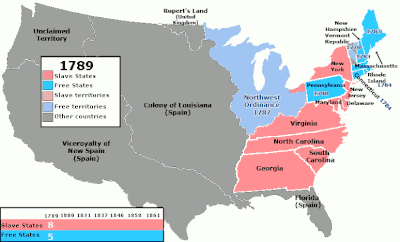
In the history of the United States of America, a slave state was a U.S. state in which the practice of slavery was legal at a particular point in time. A free state were the ones in which slavery was prohibited. Slavery was an issue that divided the country. It was one of the primary causes of the American Civil War. The Thirteenth Amendment to the United States Constitution, ratified in 1865, abolished slavery in every state and territory of the United States except in cases of punishment for criminal activity. After that time the terms became more or less obsolete because all states were free of slavery.
Early history
[change | change source]
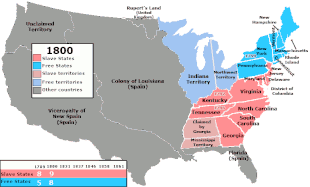
Slavery was legal and practiced in each of the Thirteen Colonies.[1] Organized political and social movements to end slavery began in the mid-18th century.[2] The desire for freedom from Britain, expressed in the American Revolutionary War, caused many black Americans to join the revolution in hopes they would be freed also. Others joined the British Army, encouraged by British promises of freedom in exchange for military service. After the British lost the war, thousands were taken to Nova Scotia.
In the 1770s, blacks throughout New England began sending petitions to northern legislatures demanding freedom. At the Constitutional Convention many slavery issues were debated and for a time slavery was a major obstacle to passage of the new constitution. As a compromise the institution of slavery was acknowledged although never mentioned directly in the constitution. An example is the Fugitive Slave Clause. By 1789, five of the Northern states had policies that started to gradually abolish slavery: Pennsylvania (1780), New Hampshire and Massachusetts (1783), Connecticut and Rhode Island (1784). Vermont abolished slavery in 1777, while it was still independent. When it joined the United States as the 14th state in 1791, it was the first state to join that had no slavery. By 1804 all of the northern states had abolished slavery or had plans in place to gradually reduce it.[3] There were 11 free states and 11 slave states. Later came the civil war.
In the South, Kentucky was created as a slave state from a part of Virginia (1792). Tennessee was created a slave state out of a part of North Carolina (1796). By 1803, after Ohio had been admitted to the United States, there were nine free states and eight slave states.[4] The geographic divide between northern free states and southern slave states became the Mason–Dixon line. In 1820, the Missouri Compromise extended the Mason–Dixon line westward as the official dividing line between free and slave states east of the Ohio River.[5]
New territories
[change | change source]
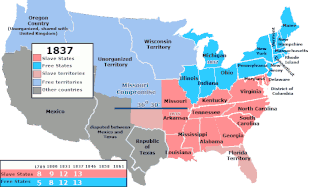
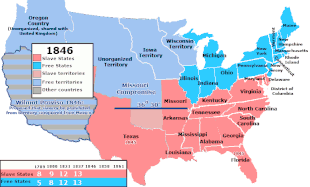
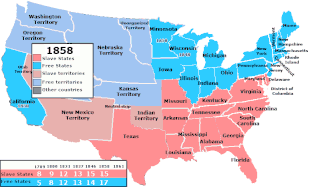
The Northwest Ordinance of 1787, passed just before the U.S. Constitution was ratified, prohibited slavery in the Northwest Territory. The southern boundary of the territory was the Ohio River. This was regarded as a westward extension of the Mason–Dixon line. The territory was generally settled by New Englanders and American Revolutionary War veterans who were granted land there. The states created from the territory – Ohio (1803), Indiana (1816), Illinois (1818), Michigan (1837), Iowa (1846), Wisconsin (1848), and Minnesota (1858) – were all free states.
War of 1812
[change | change source]During the War of 1812, the British accepted all slaves who came into their hands as free. This was without any conditions as to military service such as had been made in the Revolutionary War. By the end of the War of 1812, the momentum for antislavery reform, state by state, appeared to lose momentum. Half the states had already abolished Slavery, had prohibited it from the start or were in the process of eliminating slavery. The other half were committed to preserving slavery within their borders.
At the federal level politicians were concerned over the balance of power in the United States.[6] Each state had two senators so if there were an equal number of states on both sides of the issue, nothing could be done on the federal level. With an equal number of slave states and free states, the Senate was equally divided on issues important to the South. Both the North and South were concerned over the western territories and whether new states would be admitted as free states or slave states.[6]
Missouri Compromise
[change | change source]Controversy over whether Missouri should be admitted as a slave state, resulted in the Missouri Compromise of 1820. This specified that Louisiana Purchase territory north of latitude 36° 30', which described most of Missouri's southern boundary, would be organized as free states. Territory south of that line would be reserved for organization as slave states. As part of the compromise, the admission of Maine (1820) as a free state was secured to balance Missouri's admission as a slave state (1820). The growing population in the industrialized North resulted in the House of Representatives having more free state votes than slavery votes. To overcome this imbalance, in 1836 the House instituted a "gag rule" forbidding the House from considering any anti-slavery petitions.[7] It was repealed on December 3, 1844.[7]
Texas and the Mexican Cession
[change | change source]The admission of Texas (1845) and the U.S. obtaining the vast new Mexican Cession territories (1848) after the Mexican–American War created further North-South conflict. Although the settled portion of Texas was an area rich in cotton plantations and dependent on slavery, the territory acquired in the Mountain West did not seem hospitable to cotton or slavery. As part of the Compromise of 1850, California was admitted as a free state (1850), without a slave state pair. To avoid creating a free state majority in the Senate, California agreed to send one pro-slavery and one anti-slavery senator to Congress.
Last battles
[change | change source]The difficulty of identifying territory that could be organized into additional slave states stalled the process of opening the western territories to settlement. Slave state politicians sought a solution, with efforts being made to acquire Cuba (see Ostend Manifesto, 1852) and to annex Nicaragua (see Walker affair, 1856–57). Both were to be slave states.
In 1854, the Missouri Compromise of 1820 was superseded by the Kansas–Nebraska Act. This allowed white male settlers in the new territories to determine through popular sovereignty whether they would allow slavery within each territory. The result was that pro- and anti-slavery elements flooded into Kansas with the goal of voting slavery up or down. This led to the conflict known as Bleeding Kansas.[8] An effort was attempted to organize Kansas for admission as a slave state. It was to be paired with Minnesota as a free state. But the admission of Kansas as a slave state was blocked because of questions over the legitimacy of its slave state constitution. Anti-slavery settlers in Kansas in the 1850s were called Free-Soilers, because they fought (successfully) to include Kansas in the Union as a free state in 1861. When the admission of Minnesota proceeded unimpeded in 1858, the balance in the Senate was lost. Oregon was admitted in 1859 as a free state.
End of slavery
[change | change source]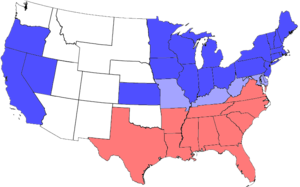
At the start of the Civil War, there were 34 states in the United States, 15 of which were slave states. Of these, 11 slave states declared their secession from the United States to form the Confederacy. The slave states that stayed in the Union were Maryland, Missouri, Delaware, and Kentucky, and were referred to as the border states. By the time the Emancipation Proclamation was made in 1863 Tennessee was already in Union control. So the Proclamation applied only to the 10 remaining Confederate states. Abolition of slavery also became a condition of the return of local rule in those states that had declared their secession. The Thirteenth Amendment to the United States Constitution abolished slavery throughout the United States on December 18, 1865, ending the distinction between slave and free states.
References
[change | change source]- ↑ Betty Wood, Slavery in Colonial America, 1619–1776 (Lanham, MD: Rowman & Littlefield Publishers, 2005), p. x
- ↑ Nell Irvin Painter, Creating Black Americans: African-American History and Its Meanings, 1619 to the Present (Oxford; New York: Oxford University Press, 2006), pp. 70–72
- ↑ Theodore Brautner Wilson, The Black Codes of the South (Tuscaloosa: University of Alabama Press, 1965), p. 15
- ↑ Slavery in the United States: A Social, Political, and Historical Encyclopedia, vol. I, ed. Junius P. Rodriguez (Santa Barbara, CA: ABC-CLIO, 2007), p. 30
- ↑ John Mackenzie. "A brief history of the Mason-Dixon Line". University of Delaware. Archived from the original on 17 July 2018. Retrieved 26 June 2016.
- ↑ 6.0 6.1 "Theme:The Slavery Debate". U.S. Capitol Visitor Center. Archived from the original on 8 September 2016. Retrieved 26 June 2016.
- ↑ 7.0 7.1 "The House "Gag Rule"". Office of Art & Archives, United States House of Representatives. Archived from the original on 8 September 2016. Retrieved 26 June 2016.
- ↑ Nicole Etcheson, Bleeding Kansas: Contested Liberty in the Civil War Era (2006) ch 1
